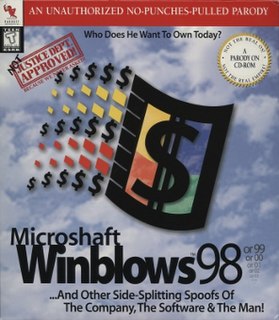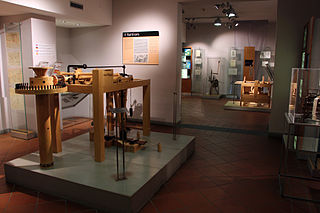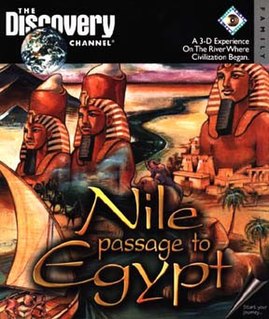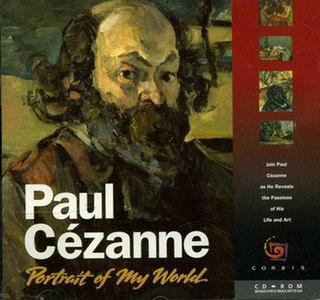Related Research Articles

The Compact Disc-Interactive is a digital optical disc data storage format that was mostly developed and marketed by Dutch company Philips. It was created as an extension of CDDA and CD-ROM and specified in the Green Book, co-developed by Philips and Sony, to combine audio, text and graphics. The two companies initially expected to impact the education/training, point of sale, and home entertainment industries, but CD-i eventually became best known for its video games.

The Codex Leicester is a collection of scientific writings by Leonardo da Vinci. The Codex is named after Thomas Coke, who purchased it in 1717; he later became the Earl of Leicester. The manuscript currently holds the record for the fifth highest sale price of any book: it was sold to Bill Gates at Christie's auction house on 11 November 1994 in New York for US$30,802,500.

BEN Group Inc (BEN) is a Los Angeles-based product placement, influencer marketing and licensing company. The company offers product placement, rights clearance, and personality rights management services for the entertainment industry.

The Codex Atlanticus is a 12-volume, bound set of drawings and writings by Leonardo da Vinci, the largest single set. Its name indicates the large paper used to preserve original Leonardo notebook pages, which was used for atlases. It comprises 1,119 leaves dating from 1478 to 1519, the contents covering a great variety of subjects, from flight to weaponry to musical instruments and from mathematics to botany. This codex was gathered in the late 16th century by the sculptor Pompeo Leoni, who dismembered some of Leonardo's notebooks in its formation. It is now in the Biblioteca Ambrosiana in Milan.
The Magic School Bus is a series of educational software video games developed by Music Pen and published by Microsoft via their Microsoft Home brand. The interactive adventures are part of the larger franchise and based on The Magic School Bus book series and public television series.

Microshaft Winblows 98 is a 1998 interactive comedy video game for Windows and the Classic Mac OS. It parodies the then-popular Windows 98 operating system, as well as Microsoft co-founder Bill Gates. Released by Palladium Interactive during the United States v. Microsoft Corp. case and at a time when Microsoft, Windows, and Gates were easy targets for jokes, the game offers a satirical take on this ripe subject matter.

Disney's Animated Storybook is a point-and-click adventure interactive storybook video game series based on Walt Disney feature animations and Pixar films that were released throughout the 1990s. They were published by Disney Interactive for personal computers for children ages four to eight years old. Starting from 1994, most of the entries in the series were developed by Media Station. They have the same plots as their respective films, though abridged due to the limited medium.

The Museo Ideale Leonardo da Vinci is located in Vinci, Leonardo da Vinci's birthplace, in the province of Florence, Italy. It is part of the Museo leonardiano di Vinci.
Critical Mass: America's Race to Build the Atomic Bomb is a 1996 multimedia presentation originally published by Corbis.

The octant projection or octants projection, is a type of map projection proposed the first time, in 1508, by Leonardo da Vinci in his Codex Atlanticus. Leonardo's authorship would be demonstrated by Christopher Tyler, who stated "For those projections dated later than 1508, his drawings should be effectively considered the original precursors..". In fact, there is a sketch of it on a page in the Codex Atlanticus manuscripts, made from the very hand of Leonardo, being Leonardo's sketch, the first known description of the octant projection.

Nile: Passage to Egypt is a 1995 educational video game by the Discovery Channel.
Augusto Marinoni was professor of romance philology at the Università Cattolica del Sacro Cuore of Milan, a member of the Commissione Vinciana and the Accademia dei Lincei. He is considered one of the greatest scholars of Leonardo da Vinci.

Virtual Murder is a four-part murder mystery adventure video game series developed by Creative Multimedia Corporation. The games were released in 1993 and 1994 for Macintosh and Windows PCs.

The Secrets of Da Vinci: The Forbidden Manuscript is an adventure game developed by Kheops Studio and published by Tri Synergy on June 7, 2006 on the PC. In 2009 it was released on the Mac OS X.

Magic Fairy Tales: Barbie as Rapunzel is a 1997 educational adventure game developed by Media Station and published by Mattel Media.
FDR is a 1996 interactive CD-ROM game developed by Corbis. The title allows players to explore the life and times of Franklin D. Roosevelt through imagery, documents, video, a timeline, and other multimedia.

A Passion for Art: Renoir, Cezanne, Matisse, and Dr. Barnes is a 1995 interactive CD-ROM by Corbis.

Paul Cézanne: Portrait of My World is a 1996 interactive CD-ROM developed by Corbis, allowing players to explore the life and work of Paul Cézanne. It was one of a series of six art-themed games released by Corbis, alongside titles like A Passion for Art: Renoir, Cezanne, Matisse, and Dr. Barnes, Volcanoes: Life on the Edge, and Critical Mass: America's Race to Build the Atomic Bomb.

Volcanoes: Life on the Edge is a 1996 interactive CD-ROM published by Corbis. It recounts the expeditions by photojournalist Roger Russmeyer to volcanoes around the world.

A.D.A.M. Life's Greatest Mysteries is an educational interactive CD-ROM game. The title aims to debunk myths about the human body, mind, sickness, and other topics.
References
- 1 2 3 4 "Gary Wolfstone reviews Leonardo da Vinci Digitized". www.wolfstonelaw.com. Archived from the original on 2015-08-02.
- 1 2 "Corbis Announces "Leonardo da Vinci" CD-ROM. - Free Online Library". www.thefreelibrary.com.
- ↑ Roush, Wade. "Setting A Standard In Multimedia Software".
- ↑ "The Curator - Edge.org". www.edge.org. Archived from the original on 2018-04-21.
- ↑ "Archived copy" (PDF). Archived (PDF) from the original on 2017-08-09. Retrieved 2018-04-20.
{{cite web}}: CS1 maint: archived copy as title (link) - ↑ "The Codescope, from Corbis's Leonardo da Vinci CD-ROM - Xconomy". Archived from the original on 2018-04-21.
- 1 2 "Tasteful. Unprofitable. Microsoft?". www.forbes.com. Archived from the original on 2018-04-21.
- ↑ "Corbis' Leonardo da Vinci: an old master in a new medium. (Corbis Corp) (Software Review)(Brief Article)(Evaluation)". 1 March 1997. Archived from the original on 21 April 2018. Retrieved 20 April 2018.
{{cite journal}}: Cite journal requires|journal=(help) - ↑ "Leonardo da Vinci. (CD-ROM book) (Software Review)(Brief Article)". 19 April 1997. Archived from the original on 21 April 2018. Retrieved 20 April 2018.
{{cite journal}}: Cite journal requires|journal=(help) - ↑ "ATPM 4.06 - Review: Leonardo da Vinci CD-ROM". www.atpm.com. Archived from the original on 2016-04-09.
- ↑ "Backwards or Forwards, the CD-Rom of Leonardo's Codex Comes Up a Winner". archive.nytimes.com. Archived from the original on 2018-04-21.
- ↑ Rapaport, Richard. "In His Image". Wired. Archived from the original on 2018-04-21.
- ↑ "Gladjes, maar Leonardo da Vinci past goed op een cd-rom". De Volkskrant. Archived from the original on 2018-04-21.
- ↑ Mossberg, Walter S. (7 November 1996). "New CD-ROM Titles Get You Acquainted With FDR, da Vinci". Wall Street Journal. Archived from the original on 2018-04-21.